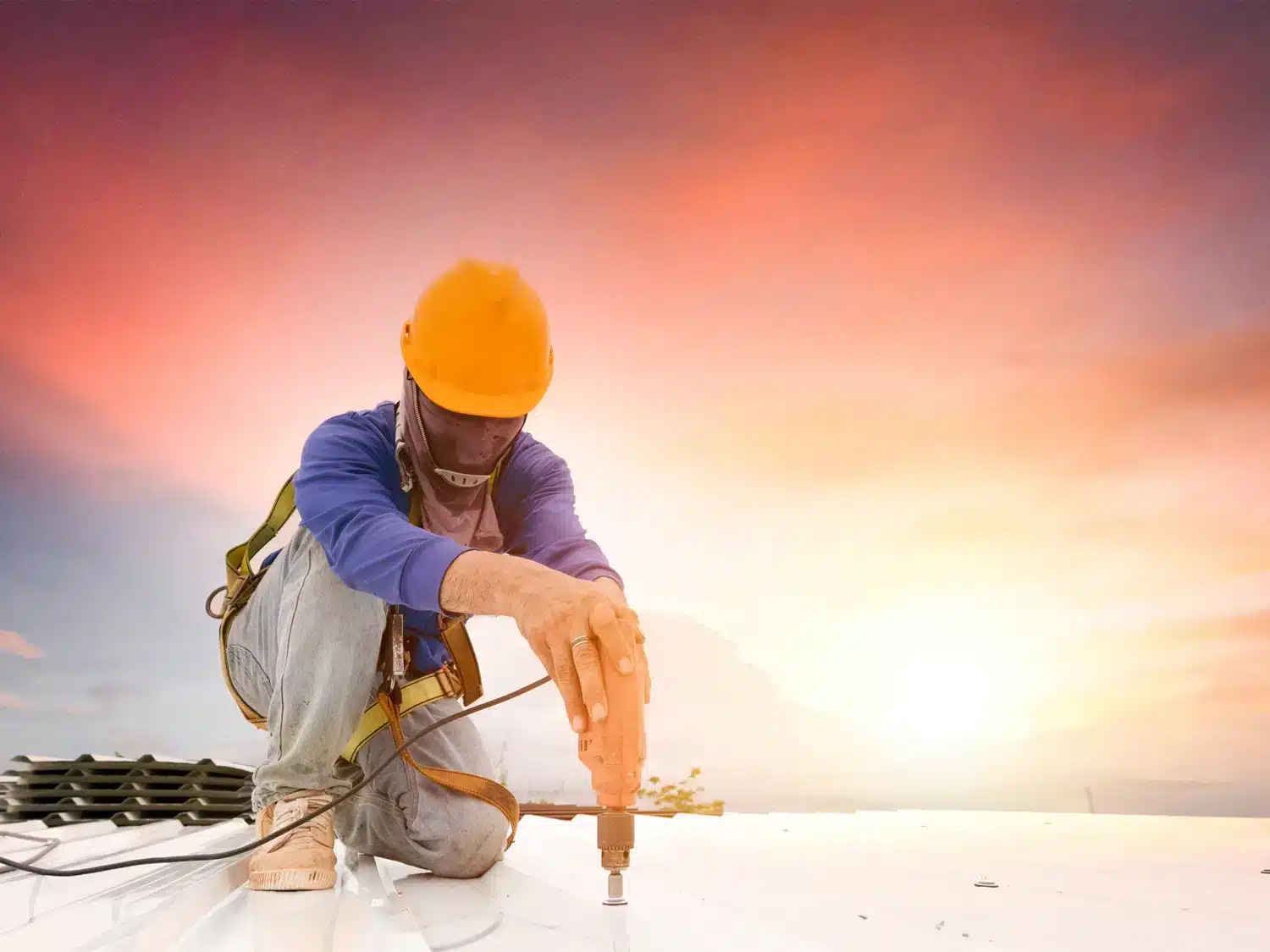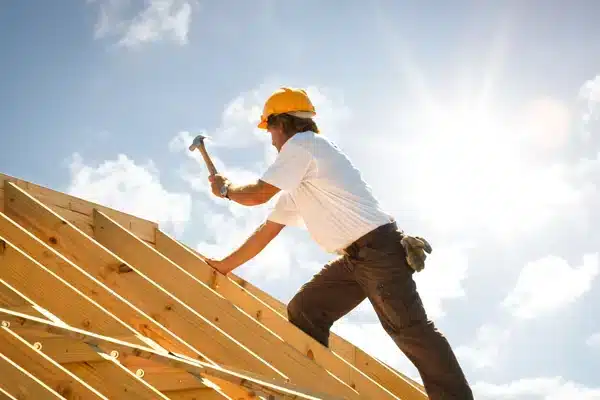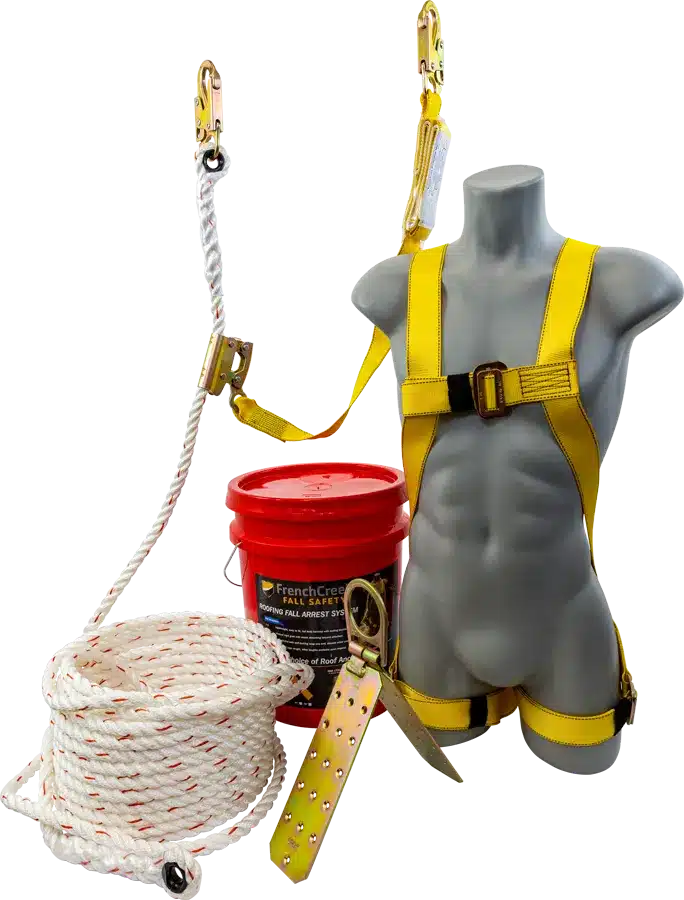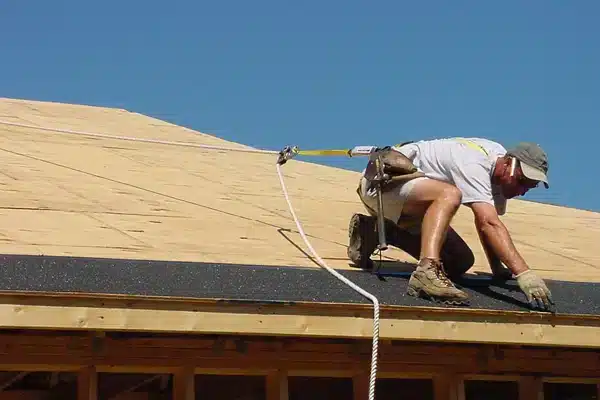Your cart is currently empty!
Is Fall Protection Required For Residential Roofers?
Yes, Residential Workers Are Required to Use Fall Protection
It is common knowledge that, in accordance with OSHA regulations, any individual exposed to a fall exceeding 6 feet in the construction sector or 4 feet in general industry (with a few specific exemptions) is mandated to be safeguarded against such an accident. Consequently, it becomes quite evident that anyone working in close proximity to the edge of a roof would necessitate personal fall arrest systems (PFAS), protective guardrails, or other forms of fall protection mechanisms. It’s safe to say that there is a unanimous consensus on this.
However, it’s not unusual to witness instances where roofers, particularly in residential settings, ignore fall protection gear. This practice, though prevalent, poses an alarming threat to their safety. As we continue to explore the reasons why roofers are ignoring fall protection, it becomes increasingly clear that such practices need to be rectified. In this article, we will thoroughly examine the necessity of fall protection for residential roofers. Moreover, we will delve into strategies available to ensure their safety in the face of potential fall hazards.
Fall Hazards On Residential Roofs

As the sun begins to cast its morning light, residential roofers prepare themselves for a demanding day ahead, embarking on tasks that involve ascending to great heights for roof installations, repairs, and maintenance. Among the paramount safety considerations prevalent in this profession, the significance of fall protection stands out prominently.
Residential roofs bring forth a bundle of hazards that underscore the paramount importance of fall protection. These hazards come in various forms, from the challenge of navigating unstable surfaces like steeply pitched roofs to unexpected hurdles like chimney stacks, skylights, or debris. What’s more, the fickle nature of weather can throw in another curveball, turning surfaces slippery and precarious. Amidst all these variables, there’s one more facet to consider: the constant movement of materials to and from rooftops. All these factors come together to emphasize the urgency of implementing rigorous fall protection measures, regardless of the setting.
Roofing Fall Statistics:
Roofing accidents are a big worry in the US, taking the lives of around 50 roofers every year due to work-related incidents. The industry’s fatality rate is about 29.9 per 100,000 full-time workers. What’s really striking is that 34% of these fatalities happen from falls at the edges of roofs. Also, 31% of fatal incidents occur during truss installation.
It’s heartbreaking that roofing work makes up a whopping 76% of deaths in residential construction. Even more alarming, a significant 18% of these deaths come from not using fall protection equipment properly. In 2019, the number of fatalities among roofers spiked by a troubling 15%, highlighting the inherent dangers tied to this profession.
According to the info gathered by the Bureau of Labor Statistics, roofing jobs are counted among the riskiest in the country. This job category alone accounts for a hefty 20-32% of all workplace deaths every year. What’s really jaw-dropping is that a whopping 75% of these deaths are because of not getting the right training or enough supervision.
Why Residential Roofers Often Ignore Fall Protection

Working as a residential roofer is a challenging job that often involves working at heights. While fall protection measures are widely recognized as essential for ensuring worker safety, it’s unfortunately common for some residential roofers to ignore these precautions. Understanding the reasons behind this non-compliance can shed light on the complexities of the issue.
1. Overconfidence and Familiarity
One key reason residential roofers might disregard fall protection is overconfidence in their skills and experience. Experienced roofers who have spent years working on various projects might feel that they are immune to accidents and can handle the risks. This overconfidence can lead to a false sense of security, causing them to ignore or downplay the importance of fall protection. In the era of the old timers, fall protection wasn’t the focal point it is today. Roofing was often a trade characterized by a “get the job done” attitude, where the emphasis was on completing tasks efficiently rather than adhering to comprehensive safety protocols. In those times, many roofers operated without the contemporary safety harnesses, guardrails, and personal protective equipment that have now become standard practice
2. Time and Efficiency Pressures
The drive for efficiency can exert a significant influence on decision-making, and this is particularly pronounced when it comes to fall protection measures. Residential roofers, fueled by the desire to complete projects swiftly, might be tempted to forgo certain safety protocols in the interest of saving time. In their minds, every moment dedicated to securing safety harnesses, checking equipment, or carefully positioning guardrails equates to a fraction of the time lost from the project timeline.
The act of ascending and descending to implement safety measures, while undeniably crucial, can be perceived as an interruption to the seamless rhythm of work. Climbing up and down to fasten harnesses or install guardrails could indeed slow down the pace of the job, at least in the immediate sense. For some roofers, this interruption can feel like a disruption that hampers productivity, costing them time and money. However, it’s essential to view this scenario from a more encompassing perspective. While the short-term efficiency gains might appear promising, they are juxtaposed against the long-term ramifications of neglecting fall protection.
3. Perception of Inconvenience
Wearing safety harnesses, establishing guardrails, and faithfully adhering to fall protection protocols can occasionally be seen through a lens of inconvenience by residential roofers. It’s undeniable that these safety measures add an extra layer of complexity to their already demanding tasks. The initial perception might be that safety gear is constraining, impeding the fluidity of movements, and introducing additional challenges to an already intricate job. This sentiment of inconvenience, albeit natural, can cast a shadow over the decision-making process when it comes to implementing fall protection measures.
However, it’s important to approach this challenge with a broader perspective. While these safety measures might introduce an element of inconvenience, they are not insurmountable obstacles. In fact, they are designed to enhance overall efficiency and safeguard the well-being of those who traverse the elevated terrain of residential roofs. The temporary shift in routine is a small price to pay for the immeasurable value of personal safety.
4. Lack of Proper Training

Proper training on the correct usage of fall protection equipment stands as a cornerstone of ensuring the safety of residential roofers. The significance of this training cannot be overstated, as it forms the bridge between possessing the necessary tools and understanding how to employ them effectively. Without comprehensive training, even the most advanced safety gear remains ineffectual, and this gap in knowledge can manifest in several concerning ways.
5. Cultural Norms and Peer Influence

In certain situations, the prevailing workplace culture within the roofing industry might unintentionally diminish the importance of fall protection. This can be rooted in historical practices where experienced roofers, who have worked without stringent fall protection for years without encountering serious accidents, contribute to a perception that such measures are unnecessary or can be somewhat relaxed.
This cultural perspective can particularly impact newcomers to the industry. When novice roofers observe seasoned veterans functioning without comprehensive fall protection, it leaves a lasting impression. The idea that experienced workers have maneuvered similar scenarios unharmed can shape the mindset of these newcomers. In this context, peer influence becomes a potent force that molds behavior and decision-making.
6. Lack of Enforcement
In many instances, due to the nature of small family-owned enterprises, the scope for stringent enforcement might be limited. The resources, both in terms of personnel and time, can sometimes be constrained, diverting attention away from the meticulous supervision of safety practices. Consequently, the implementation of fall protection measures might not be as rigorous as in larger corporate settings, leading to a variance in safety practices.
Employers hold a pivotal role in ensuring the well-being of their workforce. However, in an environment where enforcement might not be as robust, a potential gap emerges. If employers do not actively prioritize and enforce fall protection measures, or fail to provide essential safety equipment, it can inadvertently communicate to residential roofers that these precautions aren’t a significant concern. The absence of consistent enforcement can shape the perception that fall protection measures are optional rather than imperative.
7. Misunderstanding Regulations
At times, it’s not uncommon for residential roofers to find themselves in a bit of a legal labyrinth when it comes to fall protection regulations. The maze of rules and guidelines can be puzzling, leading to some roofers not having a crystal-clear understanding of what’s required. There might be a prevailing belief that these safety measures are only mandatory for certain types of projects or when working at extreme heights.
Frequently, a common belief among residential roofers is that fall protection isn’t actually mandated for their line of work. There’s a prevailing notion that adherence to OSHA guidelines is a requirement solely reserved for commercial roofers.
Competition

Many roofers openly express a certain viewpoint: that the costs associated with implementing fall protection can stand as a barrier to competing effectively in the realm of bids and contracts. This notion is more than a passing sentiment; it’s a genuine concern that is echoed by individuals deeply ingrained in the field. Responsible roofers acknowledge that adhering to fall protection rules incurs additional expenses—costs that encompass ropes, harnesses, guardrails, and the comprehensive training required for their correct usage. Following these rules, they assert, could place them at a disadvantage when pitted against home builders who opt for a different path—one that hires workers who may not adhere to the same safety measures. The challenge here is stark: the imperative to enforce safety could potentially impede their ability to compete with those who prioritize expediency over well-being.
Until a unified stance is reached among roofers, the reality remains that certain roofing contractors will continue to disregard fall protection regulations, engaging in a risky game of “hide and seek” with OSHA inspectors. Prioritizing the safety of your employees is paramount; ensuring they return home to their families unharmed should be the ultimate goal.
Roofing Fall Protection Equipment
When we delve into the realm of fall protection there’s one standout that resonates deeply with professionals: the roofing fall protection kit, affectionately known as the “compliance in a bucket” in the roofing community. This setup provides a straightforward overview and fulfills the fundamental requirements of fall protection’s ABCs. Let’s take a closer look at the components typically found within the variety of FrenchCreek roofer’s kits:

- Full Body Harness: The ease of use, lightweight design, and adaptability characterize these harnesses. They are an excellent all-around option, particularly suitable for both general construction and roofing tasks.
- Roofing Anchor: Frenchcreek Roofing Kits arrive prepped for installation. We offer an array of roof anchors tailored to match the demands of your specific task.
- Lanyard: Think of the lanyard as an extended arm – a bridge connecting the harness and the anchor. This critical link maintains continuous connection while allowing unrestricted movement.
- Rope Grab: With manual rope grabs, the worker can manually adjust the device’s position on the rope as needed. Releasing it secures the grab onto the lifeline, ensuring fall protection for the worker. These are particularly beneficial for sloped roofs as they secure the worker in a restraint position. When used properly, a worker can completely eliminate the risk of falling off a roof.
- Rope: A 5/8″ lifeline is offered in both 25′ and 50′ lengths, providing ample coverage for any residential roofing task. Includes a self-locking snap to attach to your roofing anchor.
Additional types of fall protection more often observed on commercial roofing sites include horizontal lifeline systems, guardrail systems, skylight covers, netting, and warning lines. Notably, guardrails, skylight covers, and netting serve as forms of passive fall protection systems that effectively eliminate the potential for falls. However, these systems are generally unsuitable for most residential roofs due to the configuration of roof slopes and typical residential roof design.
To Put It All Together

In the realm of residential roofing, fall protection stands as a mandated requirement that, regrettably, frequently falls by the wayside. The imperative now lies in fostering a widespread commitment among roofers to embrace fall protection in its entirety. The question arises: How can we collectively eradicate these preventable incidents?
Addressing this challenge necessitates a collective effort. While it might be tempting to view fall protection as a cumbersome impediment, its significance far surpasses any perceived inconveniences. The scales decidedly tip in favor of embracing rigorous fall protection measures when compared to the potential ramifications—be it the weight of OSHA fines or, even more distressing, the immeasurable costs associated with injuries or fatalities.
The path ahead calls for a paradigm shift, where the industry rallies around safety as an unwavering priority. Proper training, robust awareness campaigns, and fostering a culture that prioritizes worker well-being is pivotal. As technology evolves, innovative solutions tailored to the unique challenges of residential roofing should be explored. Together, we can transcend the status quo and cultivate an environment where each roofer returns home safe and sound. The time has come to affirm that the value of every life surpasses any inconvenience, ultimately shaping a safer and more responsible roofing community.